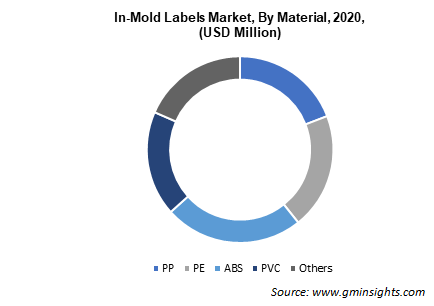Home > Chemicals & Materials > Adhesives and Sealants > Specialty Sealants > In-Mold Labels Market
In-Mold Labels Market Analysis
- Report ID: GMI5158
- Published Date: Nov 2021
- Report Format: PDF
In-Mold Labels Market Analysis
Based on materials, polypropylene in-mold labels was valued at more than USD 350 million in 2020 and is likely to witness a 7.4% CAGR through 2027. The growth of this material is attributed to the rising demand for in-mold labeling in various end-use industries including automotive, food & beverages, pharmaceuticals, etc. This material is extensively used owing to its non-toxic, moisture resistance, and excellent clarity features, which will predominantly drive the business over the assessment period.

The flexographic printing technology is likely to grow at a rapid rate of 7.5% by 2027 due to its convenience, cost-efficient & high-quality output, this printing technology is gaining popularity in the labeling of mass-produced goods. Flexography can operate on absorbents, non-absorbent, porous, and non-porous materials, which contribute to the segment share and eventually boost the in-mold labels market share in the coming years.
Injection molding segment will witness CAGR of 7.1% during the forecast time period. Injection in-mold label is a suitable process for mass production by injecting molten plastic into the mold and then cooling down to get the desired shape & size. Injection technology allows design flexibility and improves productivity with aesthetic use of colors, effects & textures.

The food & beverage industry will capture a prominent market share over the years and will generate nearly USD 1.4 billion by the end of 2027. Rising public health concerns coupled with product authentication will augment a sharp increase in product demand in the near future. These labels provide a detailed description of the product including source, nutrition, ingredients, and additional information.

Europe in-mold labels market is anticipated to grow at a sustainable rate and will acquire over 45% share through 2027. Countries including Germany, the UK, and France are consistently promoting in-mold technology in their growing packaging and manufacturing industries over the years. The increased penetration of In-mold labels in the region can be explained by the growing demand from various end-user industries.
The outlook for In-Mold labels in Europe remains positive on account of growing adoption of In-mold labels in various consumer durable products. Moreover, favorable government policies toward sustainable packaging and rising financial activities across the region are positively impacting the overall industry size throughout the projected period.

